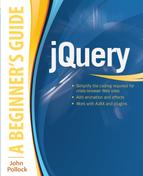Appendix
Answers to Self Tests
Chapter 1: Getting Started with jQuery
1. B. C#
2. A. A Web browser
3. C. John Resig
4. A. True
5. D. MIT License
6. B. False
7. B. <script>
8. A. <head>
9. D. <script src=“jquery-1.9.1.min.js” type=“text/javascript”></script>
10. B. The file is loaded from the server that is closest to the user, improving the speed of the file download.
11. C. $()
12. A. True
13. C. anonymous function
14. A. addClass
15. C. reusable
Chapter 2: Selecting Elements in the Document
1. The $() function returns a jQuery object, which points to all of the selected elements.
2. B. Curly braces {}
3. A. It selects elements by id.
4. C. all
5. A. True
6. C. $(“.more”).addClass(“even-more”);
7. B. False
8. A. $(“div p”)
9. B. >
10. D. $(“p:not(.about-me)”)
11. B. $(“img[alt]”)
12. A. attribute equals
13. B. False
14. A. True
15. B. element at index
Chapter 3: Event Handling
1. The ready() method allows you to begin running your script as soon as all of the elements have been loaded, but it does not wait for images or other media to finish loading.
2. C. load
3. B. noConflict()
4. D. click()
5. B. False
6. A. $(“#my-element”).click(function(event) {
7. A. True
8. B. keypress
9. D. mouseenter, mouseleave
10. A. bind()
11. D. on()
12. C. off()
13. B. False
14. A. True
15. A. trigger()
Chapter 4: Working with Styles
1. When working with CSS code, you define the selector and then define a rule within a set of curly brackets ({}).
2. B. css()
3. D. var eColor = $(“#code”).css(“color”);
4. D. shorthand
5. B. False
6. A. $(“#text-box”).css(“background-color”, “#FFFFFF”);
7. A. True
8. C. +=, –=
9. D. function
10. A. removeClass()
11. C. chaining
12. B. toggleClass()
13. A. True
14. B. offset()
15. D. scrollTop()
Chapter 5: JavaScript and the Document Object Model
1. A single-line comment begins with two forward slashes (//) and ends at the end of the line.
2. C. /*, */
3. A. keywords, reserved words
4. D. null
5. A. True
6. C. backslashes ()
7. B. False
8. A. equal, data type
9. B. else
10. C. declaration
11. B. length
12. A. nodes
13. B. False
14. C. before(), insertBefore()
15. B. detach()
Chapter 6: Animations and Effects
1. The show() method displays an element by increasing its width, height, and opacity.
2. C. toggle()
3. D. slideUp()
4. A. opacity
5. A. True
6. C. fast
7. B. False (uses milliseconds)
8. A. eq()
9. B. function
10. B. indexOf()
11. D. callback function
12. A. animate()
13. A. True
14. B. False
15. A. stop()
Chapter 7: The Event Object
1. The Event object contains properties and methods that are helpful when certain events are triggered.
2. B. type
3. C. milliseconds
4. D. Math.random()
5. A. True
6. A. which
7. B. False
8. C. key
9. C. the preventDefault() method has been called
10. B. isPropagationStopped()
11. A. stopPropagation()
12. C. preventDefault()
13. B. False
14. A. True
15. D. cancelable
Chapter 8: The DOM and Forms
1. The val() method allows you to get or set values for matched elements.
2. B. $(“#yourname”).val();
3. D. $(“input[type=text]”).val(“Enter Value”);
4. A. blur
5. B. False
6. C. focus()
7. A. True
8. D. select
9. B. “cool”
10. A. test()
11. C. i
12. B. before
13. A. True
14. B. False
15. C. required
Chapter 9: Working with AJAX
1. C. Asynchronous JavaScript and XML
2. A. server
3. A. XMLHttpRequest
4. B. load()
5. A. True
6. D. asynchronously
7. A. True
8. C. find()
9. B. JavaScript Object Notation
10. A. $.getJSON()
11. C. $.get(), $.post()
12. B. callback
13. B. False
14. A. True
15. D. serialize()
Chapter 10: Using Plugins
1. B. plugins
2. A. JavaScript
3. A. a callback function
4. D. first
5. A. True
6. B. names, values
7. B. False
8. C. $(“#my-element”).start({ time: 1000, repeat: “none” });
9. A. desktop
10. B. jquery-ui.min.css, jquery-ui.min.js
11. C. animate
12. B. widgets
13. A. True
14. A. True
15. D. jCanvas
Chapter 11: Creating Plugins
1. C. $
2. B. conflicts
3. D. Math.random()
4. B. A random number from 0 to 4
5. A. True
6. A. A random number from 2 to 6
7. B. False
8. C. $.fn
9. B. this
10. A. implicit iteration
11. D. jQuery
12. A. $.extend()
13. A. True
14. B. False
15. A. callback function
Chapter 12: Advanced Techniques and Further Resources
1. B. alert()
2. A. type
3. C. “700100”
4. D. developer tools
5. A. True
6. A. issues (bugs)
7. B. False
8. C. console
9. B. console.log()
10. C. interrupt
11. A. DOM
12. C. lint
13. A. True
14. B. False
15. Any answer is correct!
